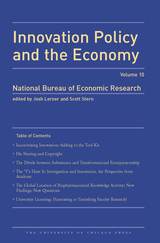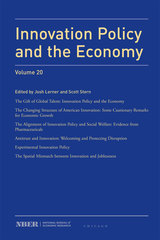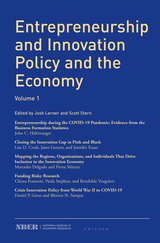2702 scholarly books by University of Chicago Press Journals and 11
have author last names that start with L
2702 scholarly books by University of Chicago Press Journals and 11
2702 scholarly books by University of Chicago Press Journals
11 have author last names that start with L have author last names that start with L
11 have author last names that start with L have author last names that start with L

Yuman Texts
Margaret Langdon
University of Chicago Press Journals, 1976
This volume includes 14 stories from 10 Yuman languages with word-by-word glosses, free translations, and grammatical notes. This format makes explicit the richness of grammar as it is used in context. This collection will be of interest to linguists specializing in Yuman languages, typologists, and aficionados of oral narrative, as well as to speakers and learners of Native American languages.
[more]

Josh Lerner
University of Chicago Press Journals
This volume provides a forum for research on the interactions among public policy, the innovation process, and the economy. Issues covered in Volume 9 include Congressional R&D spending on the physical sciences, intellectual property as a bargaining environment; pricing patents, and market design and innovation.
[more]

Josh Lerner
University of Chicago Press Journals
Innovation Policy and the Economy provides a forum for research on the interactions among public policy, the innovation process, and the economy. The distinguished contributors cover all types of policy that affect the ability of an economy to acheive scientific technological progress or that affect the impact of science and technology on economic growth. Issues covered in Volume 10 are the impact of alternative approaches for offering incentives for innovation, innovation policy and entrepreneurship in international perspective, and the impact of university patenting and licensing activities on university research.achieve
[more]

Josh Lerner
University of Chicago Press Journals

Josh Lerner
University of Chicago Press Journals
There is considerable debate regarding the implications of technological change for economic policy and the appropriate policies and programs regarding research, innovation, and the commercialization of new technology. This debate has intensified as policy makers have focused on new sources of innovation and growth in light of the continuing economic downturn and the associated focus on enhancing employment and growth. Innovation Policy and the Economy provides an ongoing forum for the presentation of research on the interactions among public policy, the innovation process, and the economy. Papers in this volume include a consideration of the complex set of innovation-policy challenges that arise in managing publicly funded research, an examination of the increasingly visible role of philanthropic funding for science, a look at the increasingly contentious issue of public funding of growth-oriented entrepreneurship, and two papers that turn their attention to the evaluation of recent federal policy changes as the result of the America Invents Act and the America Competes Act.
[more]

Josh Lerner
University of Chicago Press Journals
Appreciation of the importance of innovation to the economy has increased over the past decade. There is an active debate regarding the implications of technological change for economic policy and the appropriate policies and programs regarding research, innovation, and the commercialization of new technology. This debate has only intensified as policymakers focus on new sources of innovation and growth in light of the recent economic downturn and the associated focus on enhancing employment and growth. Four of the five papers in this year’s volume highlight the increasing role of the Internet and digitization in our understanding of the changing nature of innovation and entrepreneurship, and the impact of innovation policy. The first offers an overview of the impact of “Big Data” on the ability to conduct novel types of measurement and research in economics and related fields. The second highlights the increasingly sophisticated and creative research designs that have been used to evaluate the interplay between piracy, the availability of legitimate digital channels, and the impact of anti-piracy enforcement efforts. The third paper provides an overview of the rapidly emerging area of crowdfunding. The fourth addresses the underpinnings of much of the digital economy by focusing on the institutional logic of standard-setting organizations and the conditions that allow standard-setting bodies to function and achieve their objectives. The final paper focuses on the interplay between geographic clusters, entrepreneurship, and innovation.
[more]

Josh Lerner
University of Chicago Press Journals
This volume highlights the interaction between public policy and innovation. The first chapter documents the dramatic globalization of R&D and how this development has affected the efforts of U.S. multinationals to operate on the global technology frontier. The next chapter synthesizes research on the impact of trade shocks on innovation and explains how these shocks’ effects depend on the firms, industries, and countries affected. The third chapter examines the Advanced Research Projects Agency (ARPA) model of research management—an approach to funding and managing high-risk R&D—and offers a method for diagnosing which research efforts are “ARPA-able.” Next is a study of the Orphan Drug Act and the key changes in the U.S. healthcare landscape and in drug discovery and development since its passage in 1983. The next two chapters focus on artificial intelligence (AI). One describes how AI diffuses through the economy and discusses implications for economic inequality, antitrust, and intellectual property. The other investigates issues surrounding firm competition and labor force participation, such as data portability and a Universal Basic Income, and evaluates ways to address these issues.
[more]

Josh Lerner
University of Chicago Press Journals
The chapters in this twentieth volume of Innovation Policy and the Economy present research on the interactions among public policy, the innovation process, and the economy. One explores changes in the ability of the U.S. to attract talented foreign workers and the role of sponsoring institutions in shaping immigration policy. Another explains how the division of innovative labor between research universities and corporate labs affected productivity growth and the transformation of knowledge into new products and processes. A third reviews different innovation policies and their performance in the pharmaceutical sector. Next is a chapter on the effects of competition policy on innovation, “creative destruction,” and economic growth. A fifth chapter studies how experimental policy design can be a cost-effective way to attain program goals. The last chapter examines geographic disparities in innovation, joblessness, and technological dynamism and studies how reallocation of grants and geographically targeted entrepreneurship policy could affect labor supply and welfare.
[more]

Entrepreneurship and Innovation Policy and the Economy
Volume 1
Josh Lerner
University of Chicago Press Journals, 2022
Entrepreneurship and innovation are widely recognized as key drivers of long-term economic growth. Understanding the forces that influence them is essential for policy design. Building on the twenty-year legacy of the NBER Innovation Policy and the Economy series, Entrepreneurship and Innovation Policy and the Economy showcases recent research on entrepreneurship and entrepreneurship policy. The volume reports on five research projects. First, leveraging detailed data from the Business Formation Statistics, John Haltiwanger documents a striking uptick in new business formation during the pandemic, and considers the future economic impact of this renewed rate of business dynamism. The next two chapters focus on disparities in the degree of inclusion of women and people of color in innovation and entrepreneurship. Lisa Cook, Janet Gerson, and Jennifer Kuan examine the history of unequal access to education, training, and the practice and commercialization of invention, and the subsequent loss in innovative capacity and productivity. They also consider the potential effects of policies that address these inequalities. Mercedes Delgado and Fiona Murray complement this analysis by characterizing and analyzing the gender gap in patented innovation, including the substantial variation in inclusion of women across locations, industries, and individual firms. The remaining chapters focus on the organization of research and commercialization. Chiara Franzoni, Paula Stephan, and Reinhilde Veugelers consider the operation of current research funding systems with regard to risky research projects. They also describe the consequences of documented biases against novelty in funding decisions in the context of research on mRNA technology. Drawing on historical lessons from World War II as well as current analysis of innovation policy during COVID-19, Daniel Gross and Bhaven Sampat consider the unique challenges that arise when a crisis necessitates unusually rapid innovation and the deployment, at scale, of research findings.
[more]

Joshua Lerner
University of Chicago Press Journals
The eighteenth annual volume of the National Bureau of Economic Research’s Innovation Policy and the Economy focuses on research that explores the interplay between new technologies and organizational structures, such as networks and corporations. In the first chapter, Glenn Ellison and Sara Fisher Ellison explore how consumer search in a technology-mediated marketplace can affect the incentives for firms to engage in price obfuscation. In the second chapter, Aaron Chatterji focuses on the role of innovation in American primary and secondary education (K–12), emphasizing recent evidence on the efficacy of classroom technologies. The third chapter, by economic sociologist Olav Sorenson, considers how information, influence, and resources flow through innovation networks. The last two chapters focus on how corporate organizational structures influence innovation and dynamism. In the fourth chapter, Andreas Nilsson and David Robinson develop a synthetic framework for understanding the emergence and choices of social entrepreneurs and socially responsible firms. In the fifth chapter, Steven Kaplan argues that there is little empirical evidence to support the common claim that investor pressure for short-term financial results leads U.S. companies to systematically underinvest in long-term capital expenditures and R&D.
[more]

Nelson Lund
University of Chicago Press Journals
The Supreme Court Economic Review series applies economic and legal scholarship to the work of the United States Supreme Court. Contributions provide economic analyses of events that generate the Court's cases, its organizational functioning, its rationale, and the societal impact of these verdicts.
[more]
READERS
Browse our collection.
PUBLISHERS
See BiblioVault's publisher services.
STUDENT SERVICES
Files for college accessibility offices.
UChicago Accessibility Resources
home | accessibility | search | about | contact us
BiblioVault ® 2001 - 2024
The University of Chicago Press









